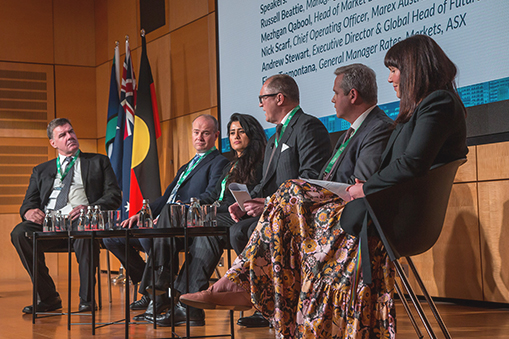Addressing more than 200 industry professionals, moderator Bill Herder, FIA’s Head of Asia-Pacific introduced the panel which included Russell Beattie, Managing Director & Head of Asia-Pacific, CME Group; Mezhgan Qabool, Head of Market Development and Sales APAC and Middle East, Eurex; Nick Scarf, Chief Operating Officer, Marex Australia Pty Ltd; Andrew Stewart, Executive Director & Global Head of Futures, Macquarie Group; and Fiona Tramontana, General Manager Rates, Markets, ASX.
Navigating global turbulence
Resiliency of exchange-traded markets was a key theme. The industry has remained operationally stable through geopolitical turbulence, this year’s mini-US banking crisis, as well as the pandemic when – in Tramontana’s words – “powerful people led Teams meetings with their children running around in the background”. In Australia, economic disturbance has been caused by the Reserve Bank lifting interest rates 12 times since May 2022. Monetary conditions have triggered price changes, creating an increased cost to trade and shortage of bond market liquidity. “The exchanges need to have a good hard think about how we get those liquidity players back and not just rely on banks,” Scarf said.
Key trends in products
It was observed that investors are managing risk across a diverse product set. Investment firms are attracted to the safety of fixed income securities. More investors are choosing exchange-traded funds (ETFs) and the venture market. There is also renewed interest in products linked to decarbonisation and ESG. From an ASX perspective, Tramontana cited healthy retail investor engagement in cash markets and equity options.
Another trend, as Qabool put it, is “towards cleared and futurised products”. Repo (repurchase agreement) clearing and record levels of foreign exchange clearing help banks, for example, mitigate risks by maintaining capital standards. Trading has also increased out of Australia in commodities and currency futures. “Futures markets continue to be a cost-effective and timely way to manage investments, diversify, rebalance, implement synthetic strategies, create modern portfolios, really effectively ‘manage to benchmarks’ or manage Alpha,” Stewart said.
Cryptocurrencies stabilise
The panel viewed cryptocurrencies as a maturing product. In the wake of recent charges against Coinbase and Binance by the US Securities and Exchange Commission, the market’s unpredictability is being tempered by regulation and institutional limits. As Stewart said, “some of the craziness has gone”. “Professional traders want to trade a regulated product on a regulated exchange – period”, Beattie said. Hong Kong has become a testing ground for crypto futures ETFs. Qabool added that Eurex’s recent listing of the FTSE Bitcoin Index Futures only eventuated following a regulatory approval process that took two years.
Changing tech landscape
Technological change will transform markets through electronification, as well as AI and algorithmic trading. Yet the cyberattack on Ion in January highlighted the vulnerabilities of cloud-hosted infrastructure and importance of preparing for the next crisis event. Interruption to the Seals trade-matching system exposed the need for modern clearing technologies. “A large chunk of the industry still operates on the FIS GMI product developed around the same time as Lotus 1-2-3,” Stewart explained. Distributed ledger technology may facilitate instantaneous clearance as give-ups increase. “In the olden days, there were clearing windows. Today, the trade just sits on the clearer’s house book,” Scarf said. “We’ve got to do more to close that risk loop and get that trade to the customer as soon as we can.”
A bright future in Asia
Panellists saw great future opportunities for the local industry. Across the world, exchanges are extending their hours to handle an influx of international trades by retail and institutional investors, the private sector and the banks. Much of this momentum is coming from the Asia-Pacific region. For example, up to 35% of trading on CME Group’s markets is from the Asian timezone. Australia serves as a convenient base for European or American firms wanting to operate around the clock.
The nation’s growing superannuation pool, the world’s fifth-largest but fastest growing, remains attractive to asset managers. Moreover, as Indian and Chinese markets expand, Australia can provide stability and guidance. Beattie observed that people are returning home post-COVID to set up trading firms who might have trained in New York, Chicago or London. “Australia has a great business and regulatory environment and governance structures,” he said. “Here in the Asia-Pacific region, we have frontier, emerging and developed markets. It’s a very exciting time and Australia can play an important role in developing that ecosystem based on the talent here.”
Other Insights

When margin calls: Clearing services eye a changing market
Australian clearing services are in a period of appraisal and transition like never before. Their role as central counterparty intermediaries in providing financial market stability has recently been pressured by serious economic and geopolitical disruptions. Persistent volatility is impacting capital efficiency, as well as capacity to manage margins.
ASX provide a quarterly report with the latest insights on market trends and announcements across ASX Interest Rate Futures, OTC Clearing, Benchmarks and Austraclear products. To receive these insights via email, please subscribe to the ASX Rates Highlights newsletter.
